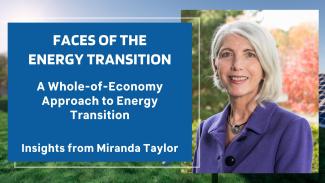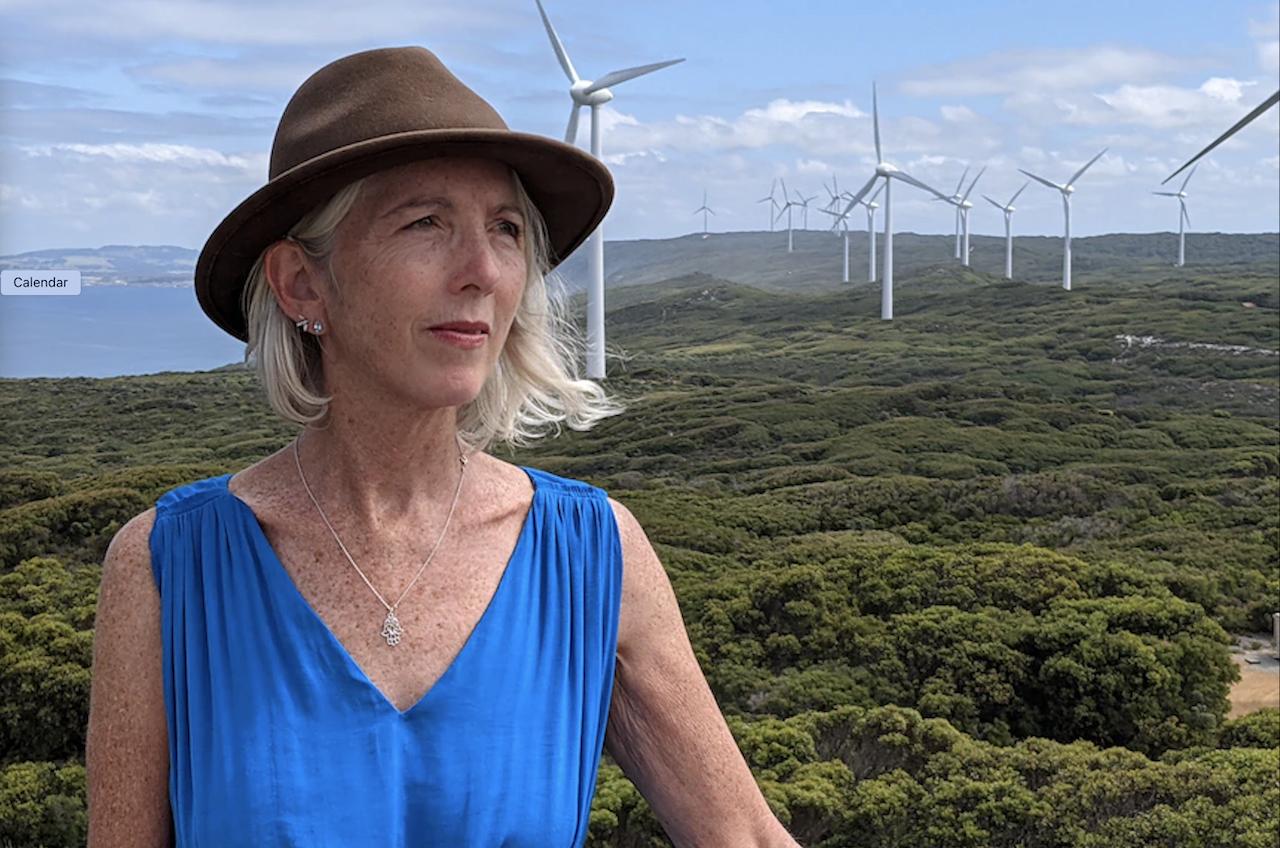
The global population is heading towards nine billion people and the demand for energy and electricity continues to grow. At the same time many parts of the world have experienced first-hand devastating climate change impacts, and this is driving the global capital investment world to move into the energy and technology solutions needed to decarbonise all industries. The energy sector must play a central role in this global journey to decarbonisation. However, achieving net zero emissions by no later than 2050 will require the transformation of entire economies and action by all industries and sectors.
What can these other industry sectors do - individually and collectively – to accelerate their action to achieve net zero carbon emissions?
For our Faces of the Energy Sector blog series, we invited energy and resources industry expert Miranda Taylor to give her insights into this ‘economy wide’ approach and how the different sectors are influencing each other to act. Miranda has been the chief executive officer of NERA (National Energy Resources Australia) since its inception in 2016.
Prior to heading NERA, Miranda has decades of experience in operational productivity, HSE and ESG leadership in the oil and gas and resources sectors. She was also involved in strategic policy and political advocacy, working with state and federal governments and regulators across Australia. Miranda has an Honours Degree from the London School of Economics.
We recently put some questions to Miranda, and you can read her insights below.
1. Over the last couple of years, the world has experienced very real and confronting climate change impacts. Do you think that in the face of this huge risk to businesses and communities, decarbonisation now makes commercial sense rather than just moral or a noble cause?
Yes - most definitely. This is one of the most interesting and compelling developments. There is a cool-headed assessment taking place across the global business and finance world of the costs and risks of climate change impacts – both from the direct impact of climate change but also from the risk of stranded assets. In my experience, financiers seldom ignore risks to their businesses, and this is driving a fundamental reshaping of global Finance.
However, the reality of climate change is now widely accepted, and many countries, industries and businesses have set themselves net zero goals, countries have introduced carbon taxes and companies are requiring action by their global supply chains. So there is in practice both a commercial and a moral drive for action. No country or business can be isolated from this global reality.
2. Is the energy transition primarily the responsibility of the energy sector or is action by other industries, governments and individuals critical to accelerate the global transition to decarbonised energy?
Addressing carbon emissions from the energy sector, including from fossil fuels and electricity, and accelerating investment in low emissions technologies and renewable energy, are fundamental to global energy transition efforts - the IEA in their report ‘Net Zero by 2050, A Roadmap for the Global Energy Sector’ has estimated the energy sector is the source of around three quarters of greenhouse gas emissions. However, to achieve net zero carbon by no later than 2050 will require the transformation of the entire economy and energy system and must be driven by action across all industries, as consumers of energy and producers of emissions and waste.
Often the assumption is that it is up to the energy sector alone to fix carbon emissions. The sector certainly does have a major role to play, however, we need to tackle carbon emissions in multiple ways and at multiple points across our economies and governments, industries, investors, communities, and individuals all need to step up and act. Other key industry sectors that must tackle their emissions, way of operating and environmental footprint include transport, mining, agriculture, and industrial processes (e.g., chemicals, steel, aluminium, cement). The latter industrial sector accounted for example for twenty four percent of direct carbon emissions in 2018, therefore is critical to achieving net zero carbon but is one of the hardest to abate sectors due to their relatively high share of emissions from feedstocks and high-temperature heat compared to other sectors. The transport sector has a similar level of emissions.

3. Do you think that the increasing integration of global supply chains means different industry sectors will influence each other to drive down emissions?
I do – and I will give you some practical examples to illustrate how the integration of industries such as high tech, manufacturing, transport, renewables, and mining means that what happens in one part of the economy impacts others.
The tech giant Apple has set its’ goal to be one hundred percent carbon neutral for its supply chains and products by 2030. Apple is achieving it by for example, the development of the first- ever direct carbon-free aluminium smelting process through investments and collaboration with two of its aluminium suppliers, and by recycling the contents of their products
A global mining major BHP has set its’ goal to achieve net zero operational emissions by 2050. BHP is achieving it by for example, renewable electricity generation integrated into the power supply for its nickel operations including solar, wind and energy storage technologies. The deal paves the way for BHP to supply “sustainable nickel” to its customers, which could soon include US EV and battery giant Tesla. This paves the way for a deal with TESLA to source ‘sustainable’ nickel for its EVs and batteries.
4. What do you think/are the biggest challenges faced by industries and sectors as they try to decarbonise?
Fundamentally industries and individual businesses have to deliver commercial return. Decarbonisation is going to require massive investment and transformation, and it will involve substantial cost in the short to medium term, so it is going to take a range of carbon pricing, policy design and incentives to support industries take the action needed.
The biggest challenge we face is that the timeframe we now have in which to act is extremely tight - we should have started this journey a decade or more ago. Reaching net zero by 2050 and limiting the rise in global temperatures to 1.5 °C is going to take massive transformation and measurable action over what is now relatively short timeframe. Countries and industries will have to be bold, collaborative and innovative and the costs and opportunities need to be shared.
It is hard for the media and public to work through the complexity of how we can get to net zero carbon – both technically and economically – and this can sometimes result in shallow positioning. Whilst we have seen an unprecedented growth in the uptake of renewables compared to any other energy source in history and a parallel fall in the cost so that renewables have become highly competitive, it is not yet anywhere near the scale we will need. Those renewables also come with some environmental challenges of their own (e.g. the enabling technologies consume precious mineral resources, land and water). And then there is the reality that many people in the developed world want green energy tomorrow but do not want to give up anything today. The hard truth is we must embrace all solutions that get us to net zero as fast as possible based on what is most technically feasible and cost effective.
There are multiple pathways and solutions to decarbonisation and each industry and business will need to make decisions on what is best for them. There is no one size fits all.
While many of the enabling low emissions technologies needed for the short to medium term are already available, they are not yet at the scale needed to make them competitive, and some technologies for the industrial and transport sectors for example (which are hard to abate) are still under development. Achieving the translation and scaling of these essential technologies is going to require industries, governments, and research organisations to collaborate and co-invest.
One great example of how collaboration can help accelerate low emissions technologies needed to develop new energy solutions such as hydrogen is the use of business and technology clustering. In Australia for example, National Energy Resources Australia (NERA), in partnership with the State Governments and small businesses, has established a network of 15 industry led regional hydrogen technology clusters. These technology business clusters have been established around key, existing hydrogen projects and technology supply chains in strategic locations that have a demonstrated capacity to support them. The network is connecting more than 300 organisations across the hydrogen value chain - from industry, research, education and training, governments, regional development bodies and peak industry organizations.
At its simplest level, a cluster is a group of firms that are operating in the same sector and are in close geographical proximity to each other. From an economic development perspective, the evidence is clear that with strong clusters comes growth in employment, especially in high value jobs. Regional economies with strong clusters have higher levels of innovation, investment, patents & successful start-ups and higher export, economic growth, wages and productivity.
Finally, navigating such a fundamental transformation is going to require governments to play a central role and poor policy design and a lack of incentives, government procurement to stimulate emerging sectors (such as carbon capture and storage and hydrogen) and public infrastructure investment will act as barriers.

5. So following up on your last point, what do you think is the role of governments in driving the energy transition, for example can they incentivise these other industries to decarbonise?
I think COVID 19 has strongly underscored the critical and central role that governments must play in accelerating the global journey to net zero by 2050 and managing that journey in a way that minimizes any negative social and cost impacts. They need support the commercialisation of R&D, de-risk early investment in emerging markets such as hydrogen and carbon capture and storage, invest in public infrastructure and balance economic, environmental, and social priorities.
In consultation with the major industry sectors, governments, educators, and universities need to design public education and skills programs that support existing workers transition to work with new technologies and energy solutions and young people gain the skills they will need to adapt and thrive in a decarbonised, technology driven, digitally enabled energy Future.
We are increasingly seeing carbon pricing signals being put in place by governments across the global marketplace. These need to be very carefully designed in consultation with industry and researchers to avoid unintended consequences. Poorly designed policy and economic and fiscal incentives will act as barriers and risk increasing carbon emissions rather than reducing.
To achieve the enormous task ahead of us we need to work together. The pathway forward is all about collaboration, inclusiveness, and innovation.
Subscribe to our Newsletter
TechnologyCatalogue.com’s Faces of the Energy Transition blog series aims to shed light on key issues surrounding the global transition to clean energy. We invite thought leaders, industry players and members of the academe to share their insights on topics that are related to the Energy Transition.
If you have suggestions on topics and/or resource persons, feel free to reach out via email at community@technologycatalogue.com.
Related blogs:
Building a tech portfolio to reduce CO2 footprint | Erik Nijveld
Energy Transition in the Middle East: Insights from Dr. Syham Bentouati
Energy Transition in the DACH Region: Insights from Bettina Bachmann
